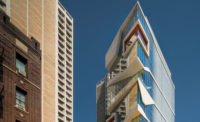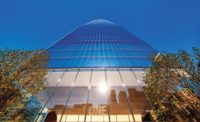New York City
Fans of Law and Order will be familiar with the imposing entry of the Thurgood Marshall U.S. Courthouse. Along with the New York County Supreme Court and its other august neighbors on New York's Foley Square, the federal courthouse, with its massive granite steps and portico of 10 Corinthian columns, is a fitting backdrop for the pursuit of justice.
The structure, which was designated a national landmark in 1987, serves a critical role in the federal judicial system as the seat of both the U.S. Court of Appeals for the Second Circuit and the U.S. District Court for the Southern District of New York. Originally known as the Foley Square Courthouse, it was renamed by Congress in 2001 after U.S. Supreme Court Justice Marshall, who had worked in the building as a Second Circuit judge (he served on the higher court from 1967 to 1991). Despite its significance, the courthouse suffered from decades of inattention and insensitive modifications. But in early 2013, it emerged from a comprehensive five-year, $314 million renovation led by Beyer Blinder Belle Architects & Planners (BBB).
Before this project got under way, some of the pieces of granite covering the concrete-encased steel structure were cracked, here and there mortar joints had failed, and water penetration was pervasive. On the roof, a number of the terra-cotta roof tiles were loose or damaged. Inside, accumulated grime covered the walls from the days before cigarette smoking was banned from the city's workplaces and public buildings. In some locations, the sumptuous finishes, which include wood paneling, decorative plaster, and 22 types of marble, had been damaged or stripped during previous renovations. And offices had been shoehorned into formerly capacious corridors, robbing the hallways of the daylight that came in through courtyard-facing windows. Security concerns also took a toll, with screening equipment proliferating haphazardly in the stately entry lobby.
The renovation's primary objective was “clarification,” says Lawrence Gutterman, project architect for BBB. He uses this term to mean the reversal of modifications made over time—due to changing function or evolving programmatic needs—that interfered with the building's original architectural configuration and expression.
Toward that end, contractors cleaned and repointed the granite facade and replaced cracked panels. The campanile's terra-cotta roof was repaired, and the lantern at the very top was dismantled and then reassembled, so that its deteriorating steel structure could be repaired. Work inside the building included demolition of the offices that had cluttered the corridors, cleaning and restoring damaged finishes, and relocation of the security-screening process to a room just off the lobby. Designers also improved security by creating a proper service and loading area from the old sally port, or prisoners' entrance. (It had long ago been rendered obsolete by the construction of an upper-floor bridge that connected the courthouse with the nearby correctional center.)
In addition to the architectural problems, the project also addressed shortcomings in the building's systems for life safety and human comfort. These deficiencies included a lack of sprinklers in key spaces such as a 25th-floor library and the entry lobby; illumination levels that conformed to 1930s standards, resulting in gloomy interiors; and a cooling system for the tower offices and courtrooms that depended on window air-conditioning units. This climate-control method was not only inefficient but also produced a distracting noise when it rained. Reportedly, the loudness of raindrops pelting the air conditioners occasionally warranted the suspension of court proceedings.
The overhaul of this infrastructure had to be accomplished in a way that satisfied the requirements of the General Services Administration (GSA), the landlord for the U.S. courts and other federal agencies. These included a mandate for LEED certification that has been in place since 2003. Adding to the challenge: all of the project goals needed to be met without impinging on the structure's historic fabric.
In order to insert the new and more efficient infrastructure without detracting from the architecture, the design team reconfigured four of the tower's 11 elevators so that they made stops only below the 17th floor (the highest publicly accessible level). The upper portion of their shafts and the entire former service elevator were then converted into vertical distribution for the mechanical systems. The change was made on the basis of traffic studies and the building's programming, says Gutterman.
For the air-handling units and other equipment, contractors commandeered the tower's top floor, which has low ceilings and small windows that make it undesirable as office space. And they concealed conduits, ducts, and piping above and behind historic finishes.
A few of the building's spaces required especially inventive solutions. The double-story library, for instance, had an original ceiling with plaster beams artfully painted to simulate wood. Diffusers and air return vents would have diminished this unique feature. So, instead, designers supplied conditioned air through the floor, from the level directly below. They also retained a mezzanine level added to a section of the library in the 1950s, in part because it provided a convenient place to inconspicuously insert sprinklers.
The new infrastructure has been so skillfully woven into the historic fabric that even the building's longtime occupants are likely to be unaware of the modifications. However, the effect of the changes to one system—the lighting—should immediately be apparent to people who were regular pre-renovation visitors. Before the recent revamp, lighting levels were low enough to cause discomfort, says Gutterman, who describes the interior's original illumination as “dismal.” But now, the building's spaces are bright and welcoming, without being overly illuminated.
The renovation project's lighting designers, Domingo Gonzalez Associates (DGA), have achieved this effect by refurbishing and, in many cases, replicating the building's handsome glass and bronze historic pendants in order to increase the number of fixtures. A typical tower elevator lobby, for example, now has six pendants instead of the original three. And in place of incandescent lamps, the historic fixtures and their replicas now house compact fluorescents behind their frosted glass shades. These were selected with special attention to their correlated color temperature (the measure of the whiteness of a light source) and their color rendering index (a measure of how well color can be perceived).
To further enhance the lighting, the design team has also created new downlights containing ceramic metal halide MR16s, seamlessly integrating them with the ceiling ornament. They have inserted these new fixtures within plaster rosettes, recreated in resin.
One of the few places where traditional incandescent lamps are found is in the main entry hall's chandeliers. But these are dimmed to low levels in order to extend their life. To illuminate the ceiling, the design team has concealed ceramic metal halide MR16 uplights in the upper part of the fixture. “We fooled the eye by sneaking in alternative sources,” says Domingo Gonzalez, DGA president.
On the outside of the building, designers had initially planned to illuminate the tower's entire shaft. But they scaled their scheme back, opting instead to accentuate only the top. To emphasize the terra-cotta tiles' golden glow, they washed the crown in long-life high-pressure sodium floodlights—a source that is rich in reds and yellows. Just below the pyramidal roof, a section of the facade set back behind a colonnade is illuminated with metal halide lamps. These are whiter and more neutral, and therefore more naturally render the stone cladding, explains Gonzalez. At the building's base, the original pendant luminaires were refurbished and relamped.
If he had been designing the lighting today instead of between 2006 and 2008, Gonzalez says he would have specified LEDs for many of the applications. The technology, which has developed rapidly in the last few years, offers several advantages, including improved efficacy (a measure of energy efficiency expressed in lumens per watt), optical precision, long lamp life, and almost full-range dimming. In addition, because LED lamps are “instant strike,” meaning they turn on without a delay, they are relatively easy to coordinate with emergency systems.
Even without the most cutting-edge technology, the combined effect of the new lighting and other building-system upgrades is a projected energy savings of 15 percent when compared to standard new construction, estimates James Standish, a senior vice president of WSP, the renovation's mechanical engineer. The savings, which helped the project earn LEED Silver, were achieved without major modifications to the building envelope's thermal properties. Such changes were considered but rejected because they were inappropriate, too expensive, or both. For instance, the project team determined that adding insulation to the building's uninsulated granite-clad brick exterior walls could potentially cause damage. Under certain cold weather conditions, moisture could become trapped within the wall, then freeze, leading to deterioration.
The team also weighed options for the building's character-defining double-hung bronze windows, which were in relatively good condition. Replacing the original single-glazing with insulated glazing units or laminated glass would have required new window sashes, as well as new frames—a prohibitively expensive proposition, says Gutterman. Adding a secondary sash was also considered, but it would have interfered with another element in the building's historic fabric: the interior's bronze radiator covers. In the end, the team decided only to clean the windows, repair them when necessary, and add a film to improve blast resistance.
Naturally, there were other strategies, in addition to those relating to saving energy, that contributed to the project's LEED rating. Among the most notable are several features aimed at another critical resource: water. On top of its six-story base, the courthouse has a 21,000-square-foot green roof which retains stormwater, keeping it out of the city's overtaxed sewer system, in addition to helping to mitigate the heat island effect. The building also deploys several conservation approaches that are calculated to save about 25 percent of the potable water used by a conventional building. Not surprisingly, the courthouse now has low-flow plumbing fixtures, many of which are controlled by sensors. But it also has a more unusual feature for an urban high-rise: a 10,000-gallon rainwater-retention tank. The water collected there is used in the cooling tower to make up for water lost during its normal operation, from evaporation and other processes. According to Standish, in commercial and institutional buildings, which often have numerous server rooms requiring conditioning year round, the cooling tower consumes more water than any other use.
Most of the people who visit the building will be blissfully unaware that it is saving water or energy, since these systems are virtually invisible to occupants. But that is as it should be. Now attorneys, prosecutors, judges, jurors, and film crews—as well as other visitors to the courthouse—can focus on the cases being tried rather than be distracted by rain pelting air conditioners or lulled to sleep in courtrooms that are too dimly lit. And, of course, they can appreciate Gilbert's architecture, which has been so successfully revived for generations to come.
People
Client:
Architect:
Personnel in architect's firm who should receive special credit:
Associate architect(s):
Interior designer:
Engineer(s):
Consultant(s):
Acoustical and Audio-Visual:
Other:
General contractor:
Photographer(s):
Renderer(s):
CAD system, project management, or other software used: Size: 611,000 square feet Cost: $314 million Completion date: January 2013 |
Products
Structural system
Manufacturer of any structural components unique to this project:
Exterior cladding
EIFS, ACM, or other:
Roofing
Other:
Windows
Glazing
Doors Metal doors: Tru-Fit
Wood doors: Peterson Geller Spurge Fire-control doors, security grilles: Overhead Door
Hardware Exit devices: Allegion
Interior finishes Suspension grid: Armstrong Cabinetwork and custom woodwork: Allcraft/PLP Paints and stains: Sherwin-Williams Wall coverings: Maharam Plastic laminate: Wilsonart Solid surfacing: Avonite Special surfacing: Dex-o-tex
Floor and wall tile: Resilient flooring: Armstrong, Johnsonite Carpet: Milliken Raised flooring: Tate
Special interior finishes unique to this project:
Lighting
Interior ambient lighting: Downlights: Edison Price, Wila, Forum, Fail-safe Task lighting: Mercury, Winona, Vode Exterior: Lumiere, Winona, Gardco, Luminis, Lightolier
Dimming Systems and other lighting controls:
Plumbing
Energy
Other unique products that contribute to sustainability: Rainwater Harvesting System: Advanced Water Technologies – Better Waters
Add any additional building components or special equipment that made a significant contribution to this project: Lockers: Republic
Detention Specialties:
Ballistic Ornamental Metal and Glass: Signage: Signs and Decals, Inc Kitchen Equipment M. Tucker |



















